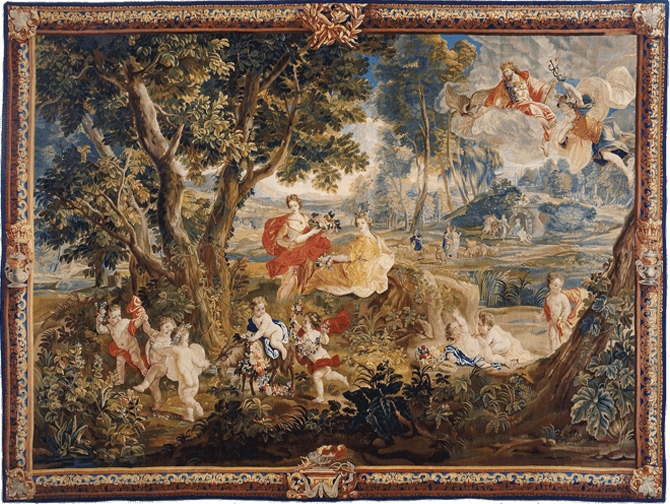Conversation/Trading of the Nymphs
An important Brussels mythological tapestry, Flemish, early 18th century. Woven by the workshop of Hendrik II Reydams, after designs by Johannes de Reyff.
Provenance:
Lord Hesketh, The Fermor-Hesketh Collection, Easton Neston, Towcester, Northamptonshire, England.
Height: 11ft 4in (345cm) Width: 15ft 1in (460cm)
This tapestry comes from a set of four all having the presences of Jupiter and Mercury on each of them indicating that they are the main subject. In this particular piece Jupiter is smitten by one of the two flower crowned women and is sending Mercury, his messenger, to tell her of his love. The children frolicking with a goat and colourful flowers create a feeling of happiness and joy.
Hendrik II Reydams was active between 1699-1719 and being the one of the most important and principal tapissier in Brussels during the time, restored the reputation of the city as an important weaving centre. He had five looms in operation in 1703. According to the later inventory of the estate of Urbanus Leyniers in 1747, who had been Reydams’ partner, the models were supplied by the painter Johannes de Reyff and Augustin Coppens drew the landscapes. Few Jupiter set of tapestries were woven and the present tapestry is therefor especially rare, in the Reydam’s records of 1712-34, there is only one set of the Jupiter tapestries recorded. The present tapestry has the rare border of hanging lamps and blue colouring and is probably the first set woven around 1700.
Easton Neston is a large grade I listed country house, built for William Fermor, 1st Baron Leominster (1648–1711), in the Baroque style to the design of the architect Nicholas Hawksmoor. Easton Neston is thought to be the only mansion which was solely the work of Hawksmoor. From about 1700, after the completion of Easton Neston, Hawksmoor worked with Sir John Vanbrugh on many buildings, including Castle Howard and Blenheim Palace. Prince Charles considers Easton Neston to be his favourite country house.
Literature: Koenraad Brosens, A Contextual Study of Brussels tapestry, dye works and tapestry workshop of Urban Leyniers. 2004, Cat no 3/8. Pages 137-139 and illustrated p428.
H.C. Candee. The Tapestry Book. 1912, p104.
H.Gobel. Tapestries of the Lowlands.1924 ,p515, 554, 555.
G.L. Hunter. The Practical Book of Tapestries. 1925, p156.
Price : P.O.A.
Share this itemPrint info/picture sheet
Arrange a viewing
Enquire further
